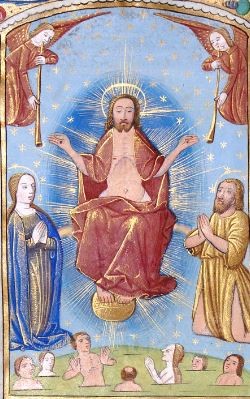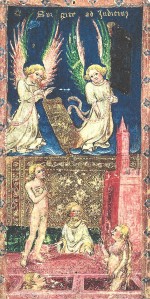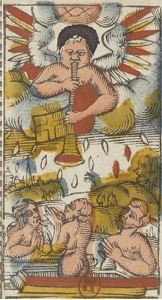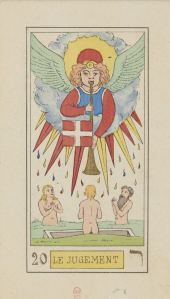Giudizio/Le Jugement/Judgment
The Judgment card captures a brief moment in a much larger story involving death, the afterlife, and the apocalypse. “Angel” is the earliest name attached to this card, and the name used most often in 15th century Italy. After tarot travelled to France in the 16th century, the card became universally known as Judgment, even though no one is shown being judged. We’ll begin by looking at early Italian cards, then at some 15th century art that gives the full story of the Last Judgment.
Early Italian Judgment Cards
The words in gold across the top of the Cary-Yale (Visconti di Modrone) trionfi card leave no doubt as to what this card is about. Above the angels, the card proclaims Surgite ad Judicium, Rise to Judgment. Angels with trumpets occupy the top half of the card. Below, three naked humans rise from tombs made of pink stone. Traditionally, naked people represent resurrected souls, and clothed people represent angels (if they have wings) or saints (if they lack wings). The man wearing a robe might be Jesus, as he is the central figure in all Last Judgment paintings. Since the banner displays heraldic symbols from both the Visconti and Sforza families, it’s possible this deck was commissioned by the Duke of Milan for the wedding of his daughter, Bianca Visconti, to the future duke of Milan, Francesco Sforza.
In this card, from the deck known as The Charles VI Trionfi, seven very animated souls emerge from their tombs. Four figures in the background are expressing their joy, but three figures in front have their arms crossed as if they are afraid of what is awaiting them. References to the last judgment in the Bible mention plural angels, without specifying the number or names. All hand painted fifteenth-century decks display two angels.
This card from the Visconti-Sforza deck is unique in showing God top center, flanked by two angels with trumpets and banners. The flag near the bottom of the trumpet belonging to the angel on our right displays a cross, the traditional symbol for the resurrection of Jesus Christ. In all block printed Judgment cards the angel is the central figure, while in all paintings of the Last Judgment, Christ in Glory is central. God holds a sword and orb to show his rulership over the universe. Three figures, a young male, a young female, and an old bearded figure share one tomb. This unusual feature is found in a few other decks.
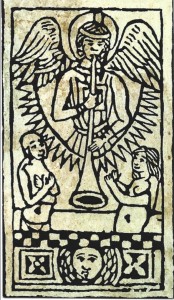


These block printed decks have been simplified to contain one angel. The Rosenwald card on the left, with its minimalist style, has only two figures rising from their graves.
The Budapest card in the center shows four very simplified figures emerging from their graves, perhaps wrapped in shrouds.
A huge angel dominates the Rothschild engraving, which is a precursor to Bolognese style cards. Since the card’s original name was “Angel”, this image is more aligned with the original intention of the card.
The Last Judgment
The scene in the tarot Judgment card shows figures representing the human soul rising from graves, where their physical bodies have been buried. According to medieval Catholic (and modern Orthodox) Church doctrine, we have a first judgment forty days after our physical death. Saints and martyrs go straight to heaven for eternity, while heretics and unrepentant sinners go straight to Hell. The rest of us spend the time before the last judgment, working off our sins in Purgatory. It is this second judgment, linked to the return of Jesus Christ on Earth, that is represented in the Tarot cards.
The concept of the Last Judgment exists in all main Western religions, including Judaism and Islam. In the Christian Bible it is found in all four gospels of the New Testament and particularly in the Gospel of Matthew. Matthew Chapter 25:31-34 of the King James Bible says:
“When the Son of Man shall come in his glory, and all the holy angels with him, then shall he sit upon the throne of his glory. And before him will be gathered all the nations; and he shall separate them one from another, as a shepherd divides his sheep from the goats: and he shall set the sheep on his right hand, but the goats on the left.” To those at his right hand he says “Come ye blessed of my Father, inherit the kingdom prepared for you from the foundation of the world”.
Matthew 25:41 continues as follows:
“Then shall he say also unto them on the left hand, “Depart from me ye cursed, into everlasting fire, prepared for the devil and his angels”.
This very large altarpiece by Rogier van der Weyden illustrates everything mentioned in the Bible, plus some images from popular Catholic belief. The scene continues the action initiated in the Judgment card, and shows what happens after the people rise up to answer the angel’s call.
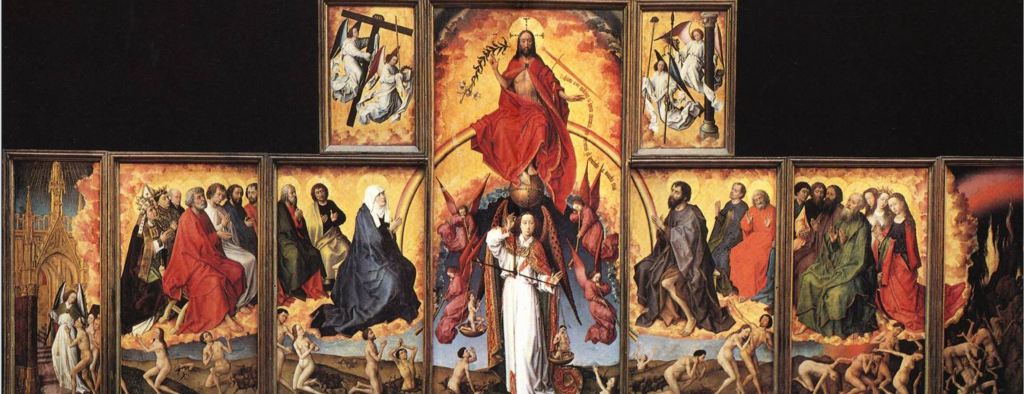
Top center, Christ sits in glory on a rainbow, his feet resting on a globe to show he rules the world. Four angels blow their trumpets to call people to the last judgment. Below Jesus, the archangel Michael weighs souls in his scale to determine their fate. Michael as a judge of souls is not in the Bible—rather it seems to have been invented by artists about the year 1100, and subsequently became an essential part of traditional Catholic belief. In the adjacent panels, Michael is flanked by the Virgin Mary and Saint John, who hear prayers for mercy and intercede on behalf of the newly-arrived in the afterlife. Various apostles and saints take up the middle of the altarpiece in a horizontal band.
Across the bottom of the painting, we see what happens immediately after the angel’s trumpet call in the Judgment card. Human souls ascend into the afterlife in a state of fear and agitation, since they don’t know what will be their fate after Michael’s judgment. The panels on the far right and left show the result of Michael weighing the souls. On the far left (to the right of Jesus) an angel conducts the souls of the blessed through the gates of heaven. On the far right, sinners are thrown into the flames of hell.
The call to the Last Judgment would be a terrifying experience for mediaeval Christians who had an acute sense of their sinfulness. They were very aware that there was no guarantee of a positive outcome from the encounter with Archangel Michael. Some tarot cards show this fear. These two French cards from the mid/-17th century, the Anonymous Tarot de Paris and the Jacques Vievil tarot, may be a continuation of an older Italian tradition.
The Tarot de Marseille Judgment Card



The cards shown above span more than 200 years, and illustrate the continuity of the Last Judgment tarot image across the centuries. The card on the left was printed by Jean Payen of Avignon in 1743 using wood blocks that were created in 1639, making this one of the earliest known Tarot de Marseille decks. The center card was printed by Nicolas Conver of Marseille in 1809 or later using woodblocks created in 1760; and on the right is a Swiss Tarot de Marseille by Francois Gassmann, 1840.
The angel occupies over half the card. Rather than several animated figures looking up at the angel in fear or amazement, the Tarot de Marseille shows three figures in static poses, one of whom looks toward the angel. The central figure with his back to us is blue or gray, the same color as the angel’s cloud. His tonsure indicates he’s a member of the clergy. The central figure is the only one emerging from a grave. The two flesh-colored people flanking him seem to be praying for a good outcome to the judgment process. This scene resembles images of Christ’s resurrection where he is shown climbing out of his tomb. Two people on either side worship Him, while the guards sleep on the ground in front of the tomb.
In the Tarot de Marseille card, the woman looks at the man with the tonsure, while the man on the right tilts his head to look up at the angel. There seems to be more going on here than just a simple response to the angel’s call. It’s been suggested that the direction of their gazes tells us that the woman looks to the Church for spiritual guidance, while the man goes directly to the source, the heavenly messenger. The naked churchman may be a way of saying that even the Church is subject to judgment, just like ordinary people. Rendering the central figure in the same color as the cloud may emphasize his spiritual nature.
The French Occult Judgment Card
French occultists like Eliphas Levi and Papus revised the Tarot de Marseille image to show a man, a woman and a child rising from their graves, representing the entirety of human experience. Oswald Wirth depicted this threesome on his card, and gave us the most complete occult interpretation of this card. Wirth tells us the mother and father face their son, who is the protagonist of the major arcana story, as he is also the Magician, the Charioteer, the Hanged Man, and many other Tarot figures. The central figure is blue because he’s a spirit.
The British Occult Judgment Card
When esoteric tarot reached Britain in the late 19th century via the Hermetic Order of the Golden Dawn, this card was re-interpreted as an internal process. At this stage of life, the great work of spiritual transformation has been accomplished. The summons to a new life comes from within ourselves, and is answered by the transformed psyche. The figures in this card are pure spirit rising ecstatically to a new life.
Interpreting the Judgment Card
Traditional card meanings follow the last judgment theme closely: An initiation experience; a symbolic death and new beginning; the completion of one phase of life and the promise of a new path ahead; and a paradigm shift or a peak experience that happens suddenly.
Card meanings favored by occultists are more transcendent: The spiritualization of matter, communicating with the divine, awakening to a spiritual life, intuition, clairvoyance, artistic genius, healing powers, and the return of health.
Contemporary interpretations are practical and psychological. You’ve evaluated your life, seen the consequences of your actions, and recognized how you have created your reality. The resulting personal transformation allows you to transcend your old self and its limiting patterns, and take a different path. What was dormant and repressed deep inside you is now waking up. You’re ready to come out of whatever closet you’ve been in and aspire to a life that wouldn’t have seemed possible to your old self.
On a more practical level, this is the card of the wake-up call. You have a sudden insight or creative breakthrough that changes everything. It could also indicate being “called out” by someone, possibly very publicly. Or it could simply mean an unexpected phone call or text message. Since the card depicts people who have been encased in their graves for years and are now coming out into the light, it can warn us that buried secrets are about to be revealed, or something that was hidden or lost is suddenly found.
Modern Judgment Cards
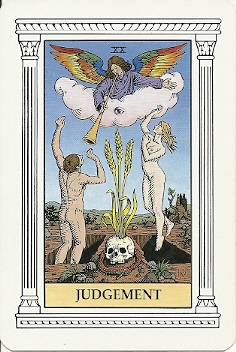


The couple from the Lovers card of the Alchemical Tarot appear in this card as pure spirit. The eye in the cloud indicates they are seeing the truth of their lives from a higher, more spiritual vantage point. The psychological work has been done, they have transcended anything that could drag them down, and they are soaring toward a new dimension. Grain growing from a skull encircled by a snake biting its tail symbolizes resurrection and eternal life.
In the William Blake Tarot, a flaming angel wakes humanity from limited thinking and materialistic delusions. Newly liberated people dance in a frenzy at the bottom of the card. A butterfly-like creature floats above the scene, symbolizing the capacity for personal transformation and a mystical union with God.
The Phoenix in the Chrysalis Tarot symbolizes the authentic self and the potential for personal transformation. You have done the work of reviewing your life, facing you dark side, and forgiving yourself, your parents and everyone else. Freed from personal limitations, you’re on the brink of soaring into a wonderful new life.
Conclusion
The biblical Last Judgment, with punishment for one’s sins and the possibility of roasting in Hell for eternity, has never influenced the interpretation of this card. The card depicts the moment of ecstatic liberation from pain, sadness and life’s troubles. All negativity is transcended and everything is seen in a new light. As we’ll see in the World card, in tarot everyone gets to paradise.
See more cards and art at
https://www.tarotwheel.net/history/the%20individual%20trump%20cards/lo%20angelo.html
References:
Ariès, Philippe. The Hour of Our Death. New York: Knopf, 1981.
Boase, T. S. R. Death in the Middle Ages: Mortality, Judgment and Remembrance. New York: McGraw Hill, 1972.
Link, Luther. The Devil: The Archfiend in Art. New York: Harry N. Abrams, 1996.
Voragine, Jacobus. The Golden Legend. Princeton University Press, 1993. pp. 472-474, 488-489.
Images
Last Judgment. Illuminated Book of Hours. Rouen, c. 1480
Tarocchi Visconti di Modrone. c. 1440, Milan. Reproduced by Il Meneghello, Milan, 2015. Collection of the Beineke Library, Yale University.
Tarocchi Charles VI, c. 1460. Restored by Marco Cesare Benedetti, Rome, 2021. Collection of Bibliothèque Nationale Française, Paris.
I Tarocchi dei Visconti. Milan c. 1450. Reproduced by Il Meneghello, Milan, 1996. Collection of Pierpoçnt Morgan Library, New York City.
The Rosenwald Deck, c. 1475. Re-created by Sullivan Hismans. Tarot Sheet Revival, 2017. Collection of National Gallery of Art, Washington D.C.
Budapest Tarot, late 15th century. Recreated by Sullivan Hismans, Tarot Sheet Revival, 2017. Collection of the Museum of Fine Arts, Budapest and the Metropolitan Museum of Art, New York City.
Rothschild Sheet, c. 1500. Collection of Bibliothèque de l’Ecole Nationale Supérieure des Beaux-Arts, Paris.
Last Judgment, Beaune Altarpiece. Rogier van der Weyden, 1451, Brussels. Collection of Hôtel-Dieu, Beaune, France.
Tarot de Paris, c. 1650. Collection of Bibliothèque Nationale Française, Paris.
Tarot de Jacques Vieville. Paris, mid-17th century. Collection of the Bibliothèque Nationale Française.
Jean Payen Tarot, Avignon 1743. Restored by Marco Benedetti, 2023. Collection of the Fournier Museum, Spain.
Nicolas Conver Tarot, Marseille, 1760. Restored by Yves Reynaud, 2017.
François Gassmann Tarot, Switzerland, 1840. Restored by Yves Reynaud, 2020. Collection of the Swiss Game Museum.
Resurrection. English Psalter, c. 1300.
Oswald Wirth Tarot, 1887. Collection of the Bibliothèque Nationale Française, Paris.
The Centennial Waite Smith Tarot Deck. London, 1909. U.S. Games System, Inc., Stamford, CT, 2009.
The Alchemical Tarot. Robert Place. Thorsons, 1995.
William Blake Tarot. Ed Buryn. Thorsons, 1995
Chrysalis Tarot. Toney Brooks and Holly Sierra. 2016

